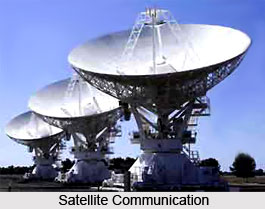 Communication in India has been a primary necessity, since the formation of the nation. The earliest possible form of communication in the prehistoric times was the carving done on the walls of the caves with sharp rocks. These inscriptions depicted the thought and language of the prehistoric men. Gradually, the papyrus leaves gave birth to later advanced form of papers that became the prime mode of communication of thoughts and views in India. Even until the British rule, the power of communication was spread through writings in newspapers, pamphlets and so on.
Communication in India has been a primary necessity, since the formation of the nation. The earliest possible form of communication in the prehistoric times was the carving done on the walls of the caves with sharp rocks. These inscriptions depicted the thought and language of the prehistoric men. Gradually, the papyrus leaves gave birth to later advanced form of papers that became the prime mode of communication of thoughts and views in India. Even until the British rule, the power of communication was spread through writings in newspapers, pamphlets and so on.
With time communication in India improved and technologies in India enabled individuals from the farthest boundary of the nation can collect, process, and exchange information. The new communication technologies in India are unlike either interpersonal communication or mass media communication, because they are interactive, defined as the degree to which the participants in a communication process have control over, and can exchange roles in, their mutual communication as well.
New communication technologies in India such as satellites, cable television, wireless telephony, the Internet, and computers have brought about noticeable changes in the society. Such developments in the communication in India have significantly aided individuals collect, process, and exchange information. The new media have certain characteristics that are similar in some respects to those of both interpersonal and mass media communication, but they are different in many other respects as well. Interpersonal communication consists of a face-to-face exchange between two or more individuals. The message flow is from one to a few individuals; feedback is instantaneous and usually plentiful, and the messages are often relatively high in socio-emotional content. In contrary, mass media communication includes all those means of transmitting messages such as radio, television, newspapers, and film that enable a source of one or a few individuals to reach out to a large audience. Some form of hardware equipment is always involved in the arena of mass communication, feedback is limited and usually delayed, and the messages are often relatively low in socio-emotional content. An evening news broadcast on Doordarshan, the Indian national network television, is an instance of mass communication.
Indian press is said to be the largest section of print media in the globe. Indian printing houses publishes more daily newspapers than any other country in Asia, covering a range of languages and educational diversity that is unmatched in the world. A survey in 2000, said that there were over 27,000 newspapers and periodicals in India that were published in 93 languages. Some 5,000 dailies were read by more than 100 million readers in 14 languages. However in a nation with a high rate of illiteracy, the effects of these newspapers and periodicals in those days were limited to an elite audience. Indian press enjoys great freedom and is therefore flourishing. Whole new segments are opening up eventually. Newspapers till date hold on the traditional roots of communication in India.
 The new communication technologies in India integrate the characteristics of both `interpersonal` and `mass communication`. Communication that occurs through these media often connects two individuals or a small number of people. In this sense, the new media or the communication technologies are like interpersonal communication; where the messages are targeted to specific individuals that are called de-massification. But interactive communication via the new media, like email on the Internet, is somewhat like mass media communication in that particular hardware equipment; including computers, satellites, and telephone lines in this case that is necessarily involved. Information exchange through the new media is interactive, indicating that the participants in a communication process have control over, and can also exchange roles in, their mutual discourse. Such interactivity is also particularly characteristic of face-to-face interpersonal communication.
The new communication technologies in India integrate the characteristics of both `interpersonal` and `mass communication`. Communication that occurs through these media often connects two individuals or a small number of people. In this sense, the new media or the communication technologies are like interpersonal communication; where the messages are targeted to specific individuals that are called de-massification. But interactive communication via the new media, like email on the Internet, is somewhat like mass media communication in that particular hardware equipment; including computers, satellites, and telephone lines in this case that is necessarily involved. Information exchange through the new media is interactive, indicating that the participants in a communication process have control over, and can also exchange roles in, their mutual discourse. Such interactivity is also particularly characteristic of face-to-face interpersonal communication.
The interactive technologies of communication in India are at the heart of the communication revolution that has been occurring in India. The computer and its various applications in satellite and cable television, telecommunications, and the Internet are bringing about great social changes in India. These technologies after becoming distinctive are converging gradually to deliver data, voice, and video in ways that were not possible before. Here a causative relationship is implied, namely, the new communication technologies are leading to changes in society. By the 1990s, computers were being used for communication purposes (such as email) rather than as number-crunchers, their original use. Therefore, social forces like government policies shared with technological innovations in the form of semiconductor advances, which made the miniaturisation of computers possible fostered the communication revolution in India. Social values, policies, and religion may help to shape the form of technologies. This social construction of technology is the process through which people give meaning to a new technology by discussing it amongst themselves. The decentralized nature of the Internet in contemporary times makes it extremely difficult for governments or other agencies to censor objectionable material, as there is no centralized point through which all electronic messages pass. Gate-keeping is impossible on the Internet. The decentralized nature of the Internet also makes it a potentially powerful tool for connecting citizens with local, regional, and national governmental departments and officials.
For several decades, computer networks were perceived as a useful tool for exchanging personal messages, like sending letters to family members or business contacts. During the 1990s, the Internet also began to be perceived as a means of buying products with a credit card, which were then delivered by an overnight delivery service to the consumer. The social meaning of the Internet changed gradually, thus creating a host of business opportunities in the nation. A cadre of entrepreneurs rushed in to found Internet-related companies, and several dozen became billionaires overnight.
The world today, including India and its achievements is aptly described as a "Global village", in which a web of information networks interconnects individuals as well organizations in nearly instantaneous global communication. The global village is a term that is increasingly inter-related by communication technologies and that is tending toward a global culture. The Internet and the World Wide Web are examples of these interconnections. At a superficial level, large cities across the world today resemble Western cities in the consumer products sold, air conditioning, traffic, and fast food.
The global village along with its communication technologies has many benefits for humankind, although the increasing degree of interconnectivity also causes certain problems. The telephone and Internet access in India is increasingly provided by telephones and computers situated in public places. Presently, India has numerous public call offices (PCOs), thousands of Internet community centers (ICCs), cyber cafes, and telecenters. Here, for a nominal fee, an individual can surf the internet, send a fax, or make a long-distance call. Thus, increasing numbers of people are gaining access to new communication technologies in India without having to own them. Nevertheless, a wide "digital divide" presently separates the urban, information-rich elite in India from their rural counterparts who are information-poor.
Indian Television has existed since last four decades and offers the finest medium of communication in India. For the first 17 years, it spread haltingly and transmission was primarily in black and white. However, television in India has come in the forefront in the past 20 years and today is the most appealing mode to reach out to people through several serials, programmes, reality shows, films and so on. The tradition of newspaper in India began with India`s struggle for independence and today is the most common and cheapest way of communicating through news, columns, advertisements and articles. The national leaders of India published several newspapers and journals and used it as a means for creating consciousness among the Indians, while today newspapers are a vital part and parcel of human existence in India. Indian Radio is presently one of the most lucrative mediums of entertainment and also communication. Indian broadcast media started first with the All India Radio. However, in contemporary India radio is more popular for its FM channels and frequencies heard all across the country. The Indian radio programmes are mostly interactive that allows free communication amongst nationwide audiences.
Government policies are highly influential in shaping the developmental agenda of communication technologies in India. Jawaharlal Nehru believed that industrialization and incorporation of communication technologies in India was crucial for the economic development of India, and when he became prime minister at India`s independence in 1947, he instituted several promising industrialisation policies. Foreseeing the requirement for vastly increased numbers of Indian engineers, he established the Indian Institutes of Technology (IITs) to prepare technologists, and the Indian Institutes of Management (IIMs) to train the future managers of plants and factories. These Institutes later played an important role in providing the skilled human resources that are leading India toward becoming an information society. The Indian government in the 1950s and 1960s launched a massive industrialization program of building steel mills, hydroelectric dams, and other heavy industry; all with the close co operation of communication technologies. In the 1990s, Indian entrepreneurs in India and abroad utilized their business acumen to amass considerable wealth by combining technical expertise with communication technologies of the nation. In the contemporary meritocracy of the global village, Indian brainpower is transformed into wealth creation with much involved of the new communication technologies.
The modern communication technologies in India stand at par with the best in the globe. In contemporary times, one is sure to find state-of-the-art technology in Indian modes of communication. The vast distances of this country have not only been easily overcome with the help of various means of communication; but they have also aided in executing overseas trade and business.



















